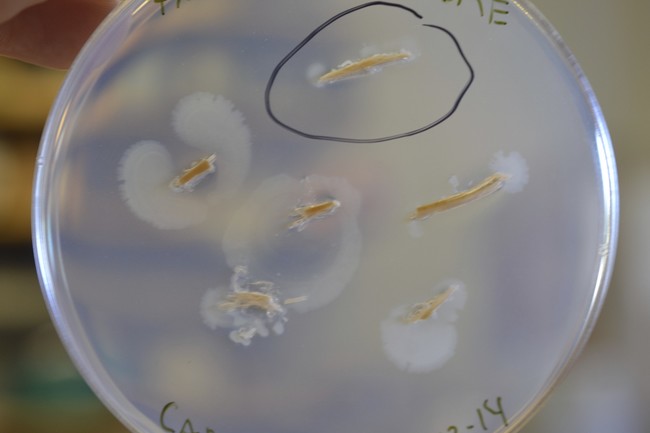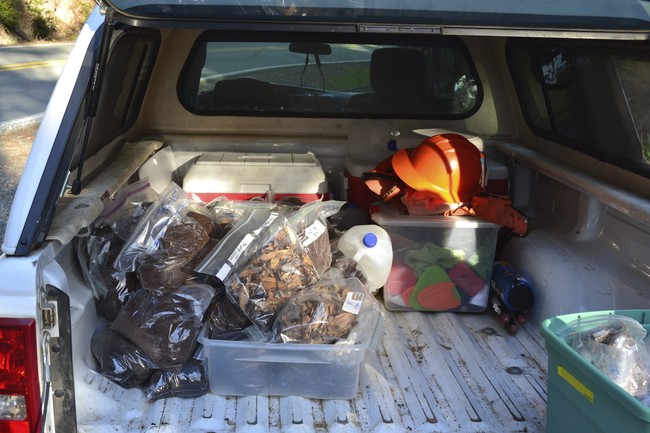Though I'm not convinced the implied vast divide between mycophiles/phobes is particularly valid as a global phenomenon, there does seem to be at least some truth to it here in the UK. Fungus inspires stronger feelings either way than other groups of non-sentient organisms, and many British and Americans in particular have trust issues with mushrooms. With that in mind, 'mycophiles' like David Robinson stand out.
David is an artist who uses mushrooms to make sculptures and luminograms, has published a children's book illustrated entirely with mushrooms, and is one of the founders of SporeBoys, a mushroom-centered food stall found in London markets. He was recently featured in a BBC Radio4's Food Programme, "Mushrooms."
 |
| One of David's fungi luminograms, commissioned to promote a perfume line called "Death, Decay, and Renewal" (LUSH, Gorilla Perfumes). See more of David's work on his website, davidrobinson.org |
Well… Fungi kind of found me! Until about a decade ago my only real experience of mushrooms was eating the odd toasted sandwich as a kid in Ireland (white cup mushrooms fried and eaten with good ol’ slightly synthetic toasted white bread) and in later life perhaps a shiitake or two floating in miso soup. I guess that for most of my life I didn't really pay mushrooms much attention unless mistaking a young specimen for my golf ball (I’m a total golf nut).
I have a creative background using mainly photography, working in the fields of editorial and advertising. I also for many years made photographic prints for other artists/photographers in my London-based studio/darkroom. In 2005 myself and a good friend and neighbor called Andrew Gellatly (a journalist with whom I collaborated on a few publishing projects) founded Sporeboys! The street market/street food scene was beginning to bubble in 2004 and we lived close-by to Broadway Market in London's east-end. We enjoyed cooking together - occasionally making sushi and having had recently discovered the joys of foraging for cep. After reading about a few growers of Japanese varieties near London we decided to approach the new market for a pitch. It was fairly easy then and no-one was specializing in fungi. We were both working freelance and we fancied something different to do during the weekend! On the first market day we bought 70 quids worth of shrooms, doubled our money and then lost the lot on a horse! We progressed from there, gambling less and offering fried tasters, then a Mushroom Medley Sandwich - and Risotto.
Since 2005 Sporeboys has appeared at many varied food markets and music festivals. Now we operate permanently at two Locations - Exmouth Market in Islington (weekdays, 12-2) and Broadway Market in Hackney (Saturdays, 9-3).
 |
| David makes temporary sculptures from the mushrooms he cooks before they head to the pot. You can find more of these curious creatures on his instagram (@sporeboys) and twitter |
Are you mostly interested in culinary mushrooms?
Yes, mainly. Although I run a food business I actually get most of my kicks from the aesthetic of mushrooms. Over the years they have infiltrated my creative practice and I use a variety in the darkroom to create Luminograms (camera-less photographic prints).
Did you cook quite a bit before starting
SporeBoys?
I'm not a trained chef although my Mum was a cookery teacher so I guess I picked up a few tips - but hey, after 160,000 portions of risotto - practice makes perfect! I'm extremely good with a knife - and it is the delicate slicing of all the beautiful Japanese mushrooms at the stall that gives me the inspiration for my Luminograms and little sculptures.
I'm not a trained chef although my Mum was a cookery teacher so I guess I picked up a few tips - but hey, after 160,000 portions of risotto - practice makes perfect! I'm extremely good with a knife - and it is the delicate slicing of all the beautiful Japanese mushrooms at the stall that gives me the inspiration for my Luminograms and little sculptures.
 |
| An image from "The Mushroom Picker," a children's book that follows the tale of a porcini's great escape from a ruthless mushroom hunter, illustrated with "fungi luminograms" |
How long have you been making the mushroom luminograms? What led you to make them? What is your process? Do you add the color-shading in after exposure?
Since 2010. I was suffering a slight creative depression prior to then - I had a small child and a mortgage, and Sporeboys had taken over my life. One day I found myself in my studio surrounded my pots/pans/gas burners and MUSHROOMS! I started writing a children's book about a mushroom that escaped The Mushroom Picker...I think I needed an escape too!I create negatives using mushrooms in the darkroom and shine light through each little sculpture onto photographic paper. The colours come from the intrinsic hue of each particular mushroom coupled with coloured filters covering the light source. .jpeg) |
| David tends the risotto. "The Mushroom Picker" is available at a very reasonable price at the SporeBoys stand, and you can purchase it from the publisher ($15+ shipping) or Amazon.com (~$20+shipping) |
Years surrounded by a beautiful child, lots of illustrated books, wild and exotic mushrooms - hey presto! Actually, one of the first luminograms that I made was a little rocket using sliced cep, a few blewitts and shimeji (as far as I can remember). I loved the free-flowing naive quality that it had - as if a child had constructed it. I decided to create a story based around some of the illustrations and it grew from there. The characters are all common names for mushrooms - Slippery Jack, Penny Bun, Lawyers Wig, Stinkhorn. Yes, the intention was to create something that mixed fact and fantasy and of course opens up the world of fungi to children. My hope also was to make a book using photography that could break away from the art market a little. It hasn't quite achieved that but there is still time. One of the biggest book chains thought the cover was to too scary for children! I'm currently working on a sequel called, 'Penny Bun Helps Save The World', and we are also considering relaunching the first book complete with a padded pink cover and glittery typeface (joke!).
[Like mushrooms? Have a child? Purchase the book at the SporeBoys stand, from the publisher ($15+shipping) or from Amazon.com (~$20+shipping).]
 |
| Make your own mushroom sculptures and dishes with fancy mushrooms available at the stand! |
Do you
ever go mushroom hunting?
Yes though not often as I am quite busy running around in central London. I have a good friend in West Sussex who is a good forager (I am a terrible forager!). I go out with him in sometimes in August/Sept searching for girolle and ceps. On a good year he spends quite a few weeks picking and transporting his harvest to top restaurants in London. In general though I always buy mushrooms for the stall from pickers and growers in the UK and Europe. I often go on great fieldtrips and recently went to Alba for the Truffle Festival. I brought back 15kg of the most beautiful dried porcini. Also Andrew and I travelled to Japan on a bit of a book research trip (and skiing in Sapporo). They adore fungi!
Sporeboys attracts a huge amount of Japanese and Italian customers - so we must be doing something right.
Yes though not often as I am quite busy running around in central London. I have a good friend in West Sussex who is a good forager (I am a terrible forager!). I go out with him in sometimes in August/Sept searching for girolle and ceps. On a good year he spends quite a few weeks picking and transporting his harvest to top restaurants in London. In general though I always buy mushrooms for the stall from pickers and growers in the UK and Europe. I often go on great fieldtrips and recently went to Alba for the Truffle Festival. I brought back 15kg of the most beautiful dried porcini. Also Andrew and I travelled to Japan on a bit of a book research trip (and skiing in Sapporo). They adore fungi!
Sporeboys attracts a huge amount of Japanese and Italian customers - so we must be doing something right.
What is your favorite mushroom-centric recipe?
Girolle lightly sautéed in butter with sage, a little garlic, sea salt and parsley - with an egg then dropped on top - Heaven!! The simplest recipes are for me the best.
 |
| Photos of David's work are from his instagram and website, used with permission |

.jpeg)




